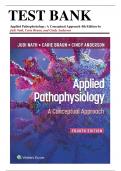TEST BANK Applied Pathophysiology: A Conceptual Approach 4th Edition by Judi Nath, Carie Braun, and Cindy Anderson TABLE OF CONTENT Chapter 1, Introduction to Pathophysiology ................................ ................................ ................................ ............... 3 Chapter 2, Altered Cells and Tissues ................................ ................................ ................................ .......................... 9 Chapter 3, Inflammation and Tissue Inflammation and Tissue ................................ ................................ ................ 18 Chapter 4, Altered Immunity ................................ ................................ ................................ ................................ .... 29 Chapter 5, Infection ................................ ................................ ................................ ................................ .................. 39 Chapter 6, Genetic and Developmental Disorders ................................ ................................ ................................ .... 50 Chapter 7, Altered Cellular Proliferation and Differentiation ................................ ................................ .................. 58 Chapter 8, Altered Fluid and Electrolyte Balance ................................ ................................ ................................ .... 66 Chapter 9, Altered Acid –Base Balance ................................ ................................ ................................ .................... 74 Chapter 10, Altered Neural Function ................................ ................................ ................................ ........................ 82 Chapter 11, Altered Mood, Attention, and Behavior ................................ ................................ ................................ 94 Chapter 12, Altered Somatic and Special Sensory Function ................................ ................................ .................. 102 Chapter 13, Altered Hormonal and Metabolic Regulation ................................ ................................ ..................... 115 Chapter 14, Altered Reproductive Function ................................ ................................ ................................ ........... 123 Chapter 15, Altered Ventilation and Diffusion ................................ ................................ ................................ ....... 133 Chapter 16, Altered Perfusion ................................ ................................ ................................ ................................ . 141 Chapter 17, Altered Nutrition ................................ ................................ ................................ ................................ . 154 Chapter 18, Altered Elimination ................................ ................................ ................................ ............................. 163 Chapter 19, Degenerative Changes in Aging ................................ ................................ ................................ .......... 173 Chapter 20, Integrated Pathophysiologic Concepts ................................ ................................ ................................ 181 Chapter 1, Introduction to Pathophysiology 1. Which term is defined as the study of the mechanisms of human body functioning? a. Pathology b. Physiology c. Anatomy d. Pathophysiology ANS: B Feedback: Physiology is the study of the mechanisms of human body functioning. Pathology is the study of changes in cells and tissues as a result of injury or disease. Anatomy is the study of body structures. Pathophysiology is the study of mechanisms of disease. PTS: 1 REF: Page and Header: 2, Defining Pathophysiology OBJ: 1 NAT: Client Needs: Physiological Integrity: Physiological Adaptation TOP: Chapter: 1 KEY: Integrated Process: Teaching/Learning BLM: Cognitive Level: Remember NOT: Multiple Choice 2. Which statement best describes the health –illness continuum? a. It is a dynamic entity. b. It is based on objective data. c. It represents two exclusive categories. d. It is focused on physical well-being. ANS: A Feedback: Health and illness are part of a dynamic continuum. It is based on one’s perceptions and is subjective. There are a variety of descriptions one can use along the continuum to describe their current state. These range from “extremely healthy” to “extremely ill.” Because it is a dynamic continuum, it represents more than two exclusive categories. The health –illness continuum includes the body, mind, and spirit, not just physical well -being. PTS: 1 REF: Page and Header: 4, Individual Health OBJ: 1 NAT: Client Needs: Health Promotion and Maintenance TOP: Chapter: 1 KEY: Integrated Process: Teaching/Learning BLM: Cognitive Level: Remember NOT: Multiple Choice 3. Which concept is often equated with health? a. Homeostasis b. Disease c. Objectivity d. An uneventful physical examination ANS: A Feedback: Homeostasis is an important body goal and is often reflected in the client’s perception of the health –illness continuum. Disease is the functional impairment of cells, tissues, organs, or organ systems. Because health is reflected in the client’s perception of the health –illness continuum, it is subjective, not objective. An uneventful physical examination would only be on aspect of health. The health –illness continuum includes the body, mind, and spirit. PTS: 1 REF: Page and Header: 4, Individual Health OBJ: 1 NAT: Client Needs: Health Promotion and Maintenance TOP: Chapter: 1 KEY: Integrated Process: Teaching/Learning BLM: Cognitive Level: Remember NOT: Multiple Choice 4. Which term is defined as the functional impairment of cells, tissues, organs, or organ systems? a. Injury b. Pathophysiology c. Disease d. Syndrome ANS: C Feedback: Disease is defined as the functional impairment of cells, tissues, organs, or organ systems. Injury causes changes to cells, pathophysiology refers to the study of mechanisms of disease, and syndrome is used to describe specific conditions with predictive patterns. PTS: 1 REF: Page and Header: 5, Population Health OBJ: 1 NAT: Client Needs: Physiological Integrity: Physiological Adaptation TOP: Chapter: 1 KEY: Integrated Process: Teaching/Learning BLM: Cognitive Level: Remember NOT: Multiple Choice 5. The nurse is planning education on the importance of wearing a helmet when riding a bike. What level of prevention is the nurse describing? a. Primary b. Secondary c. Tertiary d. Quaternary ANS: A Feedback: Primary prevention, such as wearing a bike helmet focuses on protecting people from developing a disease or injury. Secondary prevention is the early detection of disease through screening and early treatment. Tertiary prevention focuses on rehabilitation after diagnosis of a disease or injury. Quaternary prevention relates to overmedicalization. PTS: 1 REF: Page and Header: 5, Disease Prevention OBJ: 4 NAT: Client Needs: Health Promotion and Maintenance TOP: Chapter: 1 KEY: Integrated Process: Teaching/Learning BLM: Cognitive Level: Apply NOT: Multiple Choice 6. A nurse in a rehabilitation unit is assisting a client who has had a stroke with relearning how to perform activities of daily living. What level of prevention is the nurse implementing?




